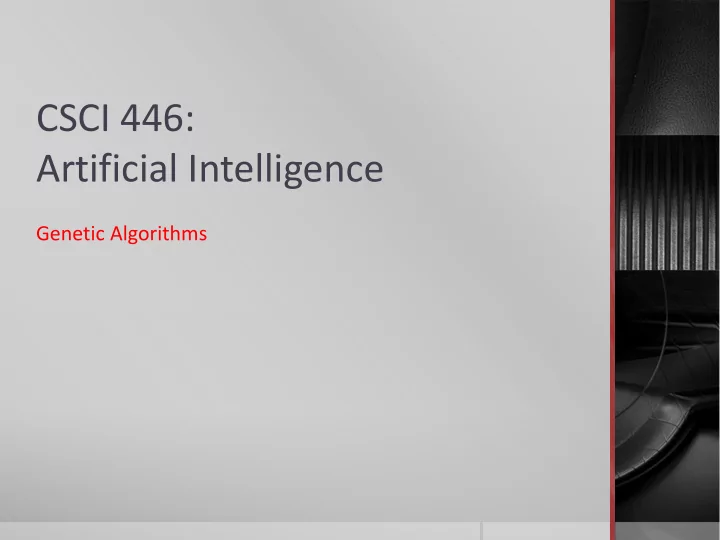

CSCI 446: Artificial Intelligence Genetic Algorithms
Genetic Algorithms Basic concept is Darwin’s theory of evolution Evolution is the process of a species adapting to and surviving in a given environment The more able to survive (the fittest) are also the more likely to reproduce, thus improving the gene pool over time 2
Genetic Algorithms Rattlesnake example Some rattlesnakes don’t have rattles In AZ? NM? This percentage has been increasing. The theory is that if people hear the rattle, the snake is more likely to get killed, so snakes without rattles are more likely to mate and reproduce and their offspring are more likely not to have rattles 3
Genetic Algorithms Two main issues of simulating evolutionary behavior Encoding – how do we represent a problem as a chromosome containing a string of genes Evaluation – how do we tell which individuals (chromosomes) are more fit than others, and therefore allowed to reproduce 4
The Development Process Step 1: Represent the domain as a chromosome Choose population size N Choose crossover probability Pc Choose mutation probability Pm 5
The Development Process Step 2: Define fitness function to evaluate the “goodness” of a particular solution Step 3: Randomly generate initial population of N chromosomes Step 4: Calculate the fitness of each chromosome 6
The Development Process Step 5: Select a pair of chromosomes for mating Base selection on both their fitness and a probability function Step 6: Create offspring by applying crossover and mutation operators Step 7: Put new offspring in the population Step 8: Repeat. Go back to step 5 until new population is of size N 7
The Development Process Step 9: Replace parent population with child population Step 10: Go to step 4 and repeat process until termination criterion is reached CSCI347/CS4206 Data Mining 8
Comparison to Traditional Optimization and Search GAs work with an encoding of the parameter set, not the parameters themselves GAs search from a population of points, not a single point GAs use a payoff / objective function, not derivatives of other auxiliary knowledge GAs use probabilistic transition rules, not deterministic rules 9
Genetic Operators Selection / Reproduction Cloning a chromosome to put in the mating pool Recall that one of the main issues in evolutionary computing is how to represent the problem parameters as a chromosome / the eventual solution The second main issue is how to evaluate the goodness, or fitness, of that chromosome / solution When you have these two things, you can then see how operators work In reproduction, each chromosome is evaluated according to a fitness function The value of its fitness influences its probability of being chosen for reproduction, that is, carrying its genes to the next generation 10
Genetic Operators Example Number String Fitness % of Total 1 01101 169 14.4 2 11000 576 49.2 3 01000 64 5.5 4 10011 361 30.9 Total 1170 100.0 2 nd one has a greater chance of being chosen for reproduction 14% Can visualize this as a roulette wheel selection 31% 5% 49% 11
Genetic Operators Crossover Proceeds in two steps Members of the mating pool are mated at random Each pair of strings / chromosomes is crossed Choose an integer position k Uniform choice between 1 and l -1 where l is the length of the chromosome Create two more strings by swapping all genes / characters from k+1 to l inclusively e.g. choose k=4 (position 4) A1 = 01101 A1’ = 01100 A2 = 11000 A2’ = 11001 12
Genetic Operators Mutation Actually plays a minor role Needed because sometimes good genetic material is lost, but most of the time, mutation has a degrading effect on the fitness Mutation is the occasional (small probability) random alteration of the value of a string position Frequency of mutation usually on the order of 1 per 1000 bit transfers Actually even smaller probability in natural populations 13
Genetic Algorithms Where is this used? Nathan Fortier’s Open Song Composer 14
Recommend
More recommend